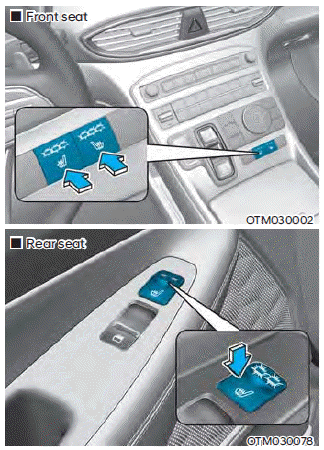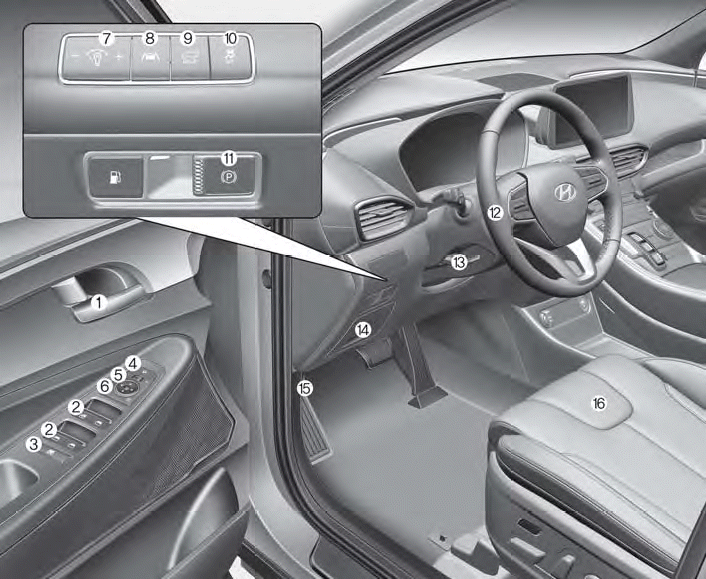Hyundai Santa Fe: Seats / Seat warmers
Seat warmers are provided to warm the seats during cold weather.
During mild weather or under conditions where the operation of the seat warmer is not needed, keep the seat warmers OFF.
WARNING
The seat warmers can cause a SERIOUS BURN, even at low temperatures and especially if used for long periods of time.
Passengers must be able to feel if the seat is becoming too warm so they can turn it off, if needed.
People who cannot detect temperature change or pain to the skin should use extreme caution, especially the following types of passengers:
- Infants, children, elderly or disabled persons, or hospital outpatients.
- People with sensitive skin or who burn easily.
- Fatigued individuals.
- Intoxicated individuals.
- People taking medication that can cause drowsiness or sleepiness.
WARNING
NEVER place anything on the seat that insulates against heat when the seat warmer is in operation, such as a blanket or seat cushion. This may cause the seat warmer to overheat, causing a burn or damage to the seat.
NOTICE
To prevent damage to the seat warmers and seats:
- Never use a solvent such as paint thinner, benzene, alcohol or gasoline to clean the seats.
- Do not place heavy or sharp objects on seats equipped with seat warmers.
- Do not change the seat cover. It may damage the seat warmer.

While the engine is running, push either of the switches to warm the driver's seat or front passenger's seat.
During mild weather or under conditions where the operation of the seat warmer is not needed, keep the switches in the OFF position.
- Manual temperature control
Each time you push the switch, the temperature setting of the seat is changed as follows:
- Front seat

- Rear seat

- Automatic temperature control
The seat warmer starts to automatically control the seat temperature in order to prevent low-temperature burns after being manually turned ON.
- Front seat

- Rear seat

If HIGH temperature is manually selected again, the temperature will be controlled automatically.
- When pressing the switch for more than 1.5 seconds with the seat warmer operating, the seat warmer will turn OFF.
- The seat warmer defaults to the OFF position whenever the ignition switch is ON.
- Auto Comfort Control (for driver’s seat) (if equipped)
- The seat warmer automatically controls the seat temperature depending on the ambient temperature and the set climate control temperature when the engine is running. If the seat warmer switch is pushed, the seat warmer will have to be controlled manually. To use this function, it must be activated from the Settings menu in the AV/AVN system screen.
- The seat warmer defaults to the OFF position whenever the ignition switch is ON. However, if the Auto Comfort Control function is ON, the driver’s seat warmer will turn on and off depending on the ambient temperature and the set climate control temperature.
For more details, refer to the separately supplied Infotainment manual with your vehicle.
Information
With the seat warmer switch in the ON position, the heating system in the seat turns off or on automatically depending on the seat temperature.
 Rear seat head restraint
Rear seat head restraint
The rear seats are equipped with head restraint in all the seating positions
for the passenger’s safety and comfort.
Adjusting the height up and down
To raise the head restraint:
1...
 Air ventilation seat
Air ventilation seat
The air ventilation seats are provided to cool the front seats by blowing air
through small vent holes on the surface of the seat cushions and seatbacks...
Other information:
Hyundai Santa Fe (TM) 2019-2025 Owner's Manual: Liftgate
Opening the liftgate Make sure the vehicle is in P (Park) and set the parking brake. Then do one of the following: 1. Unlock all doors with the Door Unlock button on your remote key or smart key. Press the liftgate handle button and open the liftgate...
Hyundai Santa Fe (TM) 2019-2025 Service Manual: Stop Lamp Switch. Schematic diagrams
..
Categories
- Manuals Home
- 4th Generation Santa Fe Owners Manual
- 4th Generation Santa Fe Service Manual
- Resetting the power liftgate
- Troubleshooting
- Smart liftgate
- New on site
- Most important about car
Interior Overview

1. Inside door handle
2. Power window switches
3. Power window lock button/Electronic child safety lock button
4. Side view mirror folding button
5. Side view mirror control switch
6. Central door lock switch
7. Instrument panel illumination control switch
